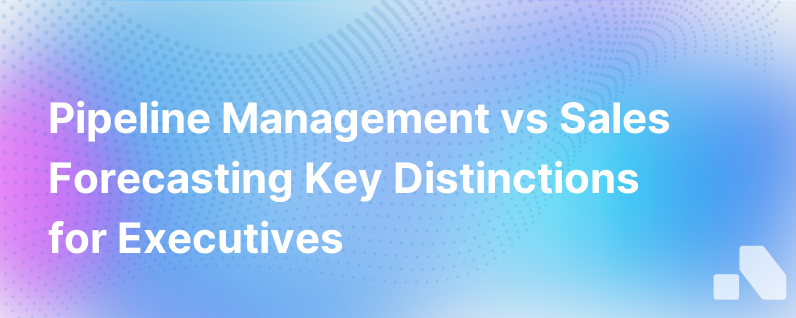
In the world of B2B sales, two terms are often bandied about — pipeline management and sales forecasting. To the uninitiated, these might seem interchangeable, but the truth is that they embody fundamentally distinct aspects of the sales process. Understanding this distinction is not merely a terminological nicety but rather a critical strategic imperative for any sales team aiming for peak performance.
Pipeline Management: The Tactical Approach to Sales Progression
At its core, pipeline management revolves around the oversight and handling of each opportunity within your sales process. It's the pursuit of moving deals through the sales funnel, from initial prospecting to closing the deal. Effective pipeline management is akin to a well-oiled machine, where every cog (lead) is meticulously monitored and pushed forward with due diligence.
The tactical execution of this involves:
- Overseeing each stage of the deal: This is about knowing the exact status of any deal at a point in time, whether it's in the prospecting stage, needs analysis, proposal, negotiation, or closing phase.
- Identifying bottlenecks: By tracking the progress of deals, sales teams can pinpoint stages where leads consistently get stuck or drop off.
- Enhancing conversion rates: With insights garnered from monitoring deal flow, strategies can be refined to improve the chances of converting a lead at each stage.
- Allocating resources efficiently: Knowing where opportunities lie allows for sales reps to focus their energy and resources on the most promising deals.
In practical terms, pipeline management demands a robust CRM tool, which acts as a command center, giving visibility into the pipeline and enabling the sales force to track progress, log interactions, and move prospects through the sales funnel.
Sales Forecasting: The Strategic Art of Predicting Revenue
Sales forecasting, on the other hand, is the analytical side of the coin, where past data, statistical analysis, and predictive modeling are applied to forecast future sales revenue within a given period. It's the compass that guides the sales strategy, providing insights into expected outcomes based on various influencing factors like seasonal trends, economic conditions, and team performance.
Here's what sales forecasting encapsulates:
- Estimating future sales: This is about producing a quantifiable prediction on the sales that are expected to close.
- Guiding strategic planning: Sales forecasts help in setting realistic targets, budgeting, and planning future growth strategies.
- Managing expectations: Accurate forecasts keep stakeholders informed and help manage the expectations of investors, executive teams, and the sales force itself.
- Allocating future resources: By anticipating sales volumes, companies can plan for production, inventory management, and staffing needs.
Executing sales forecasting demands not just a CRM with historical data but also a robust understanding of market patterns and possibly the assistance of data analytics tools that can project trends and outcomes.
The Key Differences: Focus, Functionality, and Time Frame
Here’s a breakdown of the key differences between pipeline management and sales forecasting:
-
Focus:
- Pipeline Management: Focuses on the individual deals and the activities required to move them to completion.
- Sales Forecasting: Focuses on the big picture, deriving a holistic estimate of sales outcomes over a period.
-
Functionality:
- Pipeline Management: Centered on the operational aspect of sales — tracking and nurturing leads.
- Sales Forecasting: Utilizes analytics to project future outcomes, often for strategic decision-making.
-
Time Frame:
- Pipeline Management: Concerned with current and short-term scenario sales activities.
- Sales Forecasting: Often looks at a longer-term time horizon, such as quarterly or annually.
The Interplay of Pipeline Management and Sales Forecasting
While distinct, these elements are not independent. Good pipeline management feeds into more accurate sales forecasting, and vice versa. Here's how they interplay:
- Data-driven decisions: The health of the pipeline directly impacts the accuracy of forecasting. The more detailed your knowledge of the current pipeline, the more accurate your future sales projections will be.
- Feedback loop: Forecasting can inform pipeline management. If forecasts reveal a potential shortfall, sales teams can pivot and intensify pipeline efforts to meet targets.
- Contingency planning: Forecasting helps in managing risk by preparing for potential pipeline shortfalls with proactive measures.
Why It Matters: Beyond Terminological Precision
Why is this distinction critical for any sales-focused organization?
- Efficient resource allocation: By precisely understanding where their efforts need to be concentrated — either on moving current deals along or planning for future quarters — organizations can allocate their resources optimally.
- Improved sales outcomes: Teams that excel at both pipeline management and sales forecasting tend to hit their targets more consistently and adapt to changing market conditions with greater agility.
- Strategic advantage: A nuanced understanding of both domains helps a business not only contend with the present but also actively shape its future trajectory.
Conclusion
In conclusion, both pipeline management and sales forecasting are pivotal in their own right, serving different but complementary functions in the sales process. Mastery of both concepts allows for a harmonious synergy that can exponentially amplify sales success. This understanding is vital for establishing a competitive edge and ensuring the sustained growth of any B2B sales-oriented business.
For those within the B2B realm, recognizing the intricate balance between managing the present pipeline and forecasting future sales outcomes is more than academic—it's a critical factor in driving sales efficiency and achieving growth objectives. Tools like Aomni serve to streamline these processes, integrating real-time pipeline data with advanced analysis to enhance both tactical and strategic sales functions. By leveraging such tools effectively, sales teams ensure they are not only geared up for current success but also prepared for tomorrow's challenges.